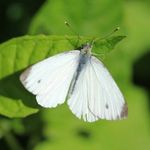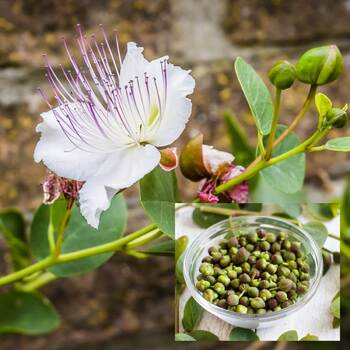
How to Grow Caper Bush Seeds
Grow Guide #2492
Family: Capparaceae
Binomial name: Capparis spinosa
Life Cycle: Perennial
This 'How to Grow' guide details everything a home gardener needs to know to plant, grow and care for Caper bush (Capparis spinosa).
When to Sow Caper bush Seeds
Caper bush is a perennial plant that grows year round in climates with hot summers and low humidity. Use the table below to identify the best time of year to sow caper bush seeds in your climate.
| JAN | FEB | MAR | APR | MAY | JUN | JUL | AUG | SEP | OCT | NOV | DEC | |
|---|---|---|---|---|---|---|---|---|---|---|---|---|
| Cool | ||||||||||||
| Temperate | ||||||||||||
| Sub-Tropical | ||||||||||||
| Tropical | ||||||||||||
| Arid |
Preparation
Caper bush plants are best grown in full sun. Choose a location that will receive at least 6 hours of full sun each day.
Caper bush plants are perennial, meaning they live for several years. Choose a permanent position where plants can grow undisturbed by regular digging.
Caper bush plants need a very well drained soil. In most cases there is no need to enrich soil with manure or other fertilisers. Prepare soil by weeding it thoroughly and digging it over to loosen it. Keep the area free of weeds until planting. Learn more about preparing soil for planting here.
How to Sow Caper bush Seeds
Stratifying seeds prior to planting may improve the speed and success of germination. Stratification involves exposing the seeds to a period of cold temperature which for some species helps to break dormancy and spur the seeds to germinate. Read more about stratification here.
Caper bush seeds grow best when they are raised in trays or other containers and transplanted to the garden once established.
- Fill trays, punnets or jiffy pots with a good quality seed-raising mix, or use soil starter pellets.
- Sow seeds 2mm deep.
- Keep soil moist but never wet or dry.
- Seeds should germinate in around 14-28 days at a soil temperature of 20-25°C.
- Transplant seedlings to the garden once they have their first true leaves and are large enough to handle (usually 5-10cm tall).
- Plant out, spacing plants 150cm apart.
Tip: Seeds of this variety can be slow to germinate. Take note of the expected germination time, be patient and follow the recommended depth and temperature guidelines closely for the best chance of success.
Optional: In cool climates caper bush seeds can be sown indoors 6 weeks before the last expected frost. Grow them in a warm position with plenty of natural light.
How to Grow Caper bush
For the first two years caper bushes may need watering during the growing season. Water when the soil is dry about 5cm below the surface. Water deeply in the early morning or late afternoon.
Caper bush plants are drought tolerant once established and grow best in soil that is dry and very well drained. Let the soil dry out between watering, and only water when the soil is dry about 10cm below the surface (test this by scratching away a little soil with your finger), even in summer. Water deeply in the early morning or late afternoon. Avoid watering the leaves of plants to avoid fungal diseases. Learn more about watering here.
If soil was well prepared no extra fertiliser should be necessary. In poor soil or to give your plants an extra boost, application of a balanced fertiliser or one formulated for fruit and vegetables can be beneficial:
- Apply slow release fertiliser at the recommended rate when transplanting or when seedlings are 5-10cm tall.
- Apply liquid fertiliser at the recommended rate and frequency while plants are fruiting or flowering.
Caper plants are deciduous or semi-deciduous. Prune branches hard in winter to encourage dense new growth; buds and fruit are produced on the new season's growth.
Caper plants are slow growing. They will take 3 to 4 years to produce buds and flowers.
How to Harvest Caper bush
Caper bush should be ready to harvest in approximately 3-4 years.
Plants produce edible buds (capers) and berries (caperberries). Neither can be eaten when raw.
Caper buds are ready to harvest when they are small (about the size of a pea). Harvest buds using your thumb and forefinger to twist and remove them from the bush. Harvest buds regularly. Caper buds can be cured and preserved in salt or pickled in vinegar.
Caperberries form after the flowers have died. Caperberries are ready to harvest when they are 6-8cm long. Harvest caperberries by cutting with snips/secateurs or by twisting to separate them from the stem. Caperberries can soaked in salty water and then pickled in vinegar.
Common Problems when Growing Caper bush
Like all plants, caper bush is susceptible to some pests, diseases and other problems. Below is a list of the most common problems gardeners encounter when growing caper bush plants:
 Cabbage moth and cabbage white butterfly have white or grey wings with distinctive markings. They lay their eggs on the underside of leaves. Their caterpillars feed on the leaves, creating large holes and sometimes skeletonising the leaves. Use netting to exclude butterflies and moths or decoys to deter them. Pick the caterpillars off the plants or use an appropriate spray in a selective and targeted way. Read more about cabbage moth and cabbage white butterfly here.
Cabbage moth and cabbage white butterfly have white or grey wings with distinctive markings. They lay their eggs on the underside of leaves. Their caterpillars feed on the leaves, creating large holes and sometimes skeletonising the leaves. Use netting to exclude butterflies and moths or decoys to deter them. Pick the caterpillars off the plants or use an appropriate spray in a selective and targeted way. Read more about cabbage moth and cabbage white butterfly here. Slugs and snails are molluscs that feed on tender leaves and shoots, mostly at night, leaving slimy trails behind them. Control them by removing their hiding places, keeping free range poultry, collecting them by torchlight or by placing traps. Read more about slugs and snails here.
Slugs and snails are molluscs that feed on tender leaves and shoots, mostly at night, leaving slimy trails behind them. Control them by removing their hiding places, keeping free range poultry, collecting them by torchlight or by placing traps. Read more about slugs and snails here.


.png)



